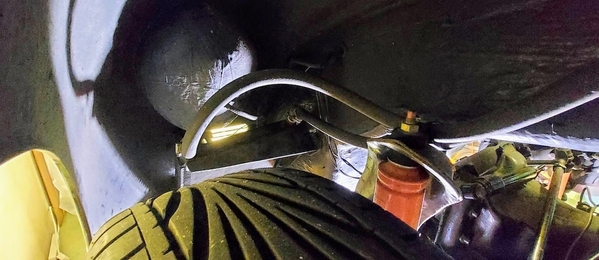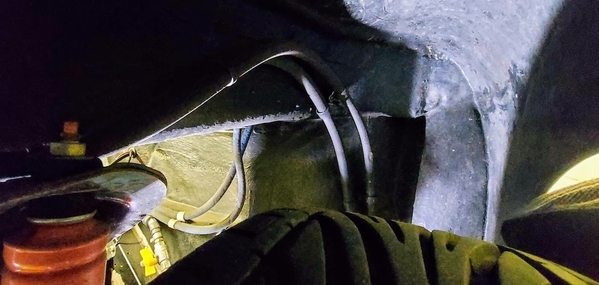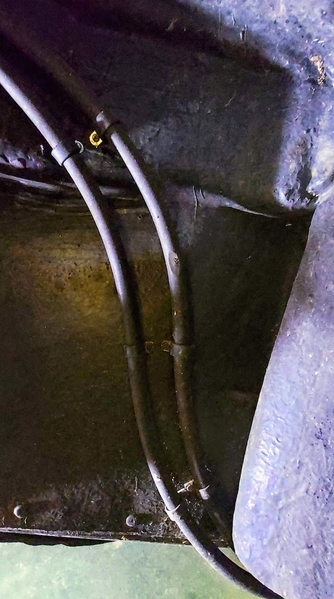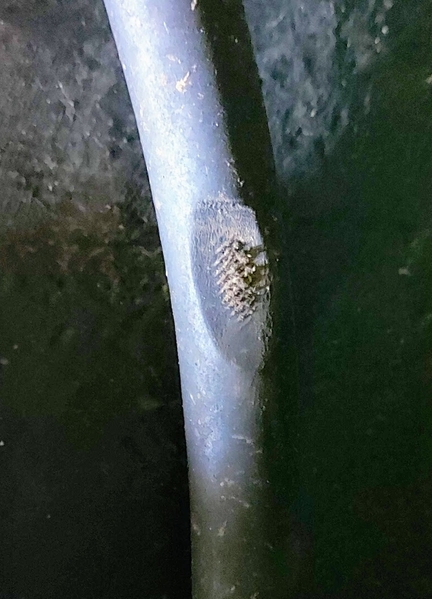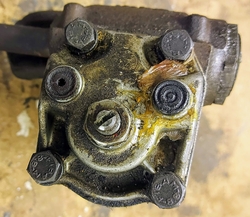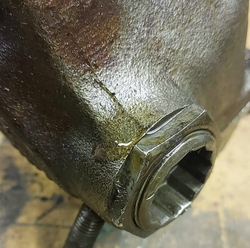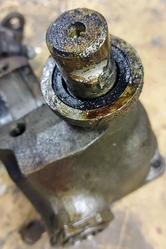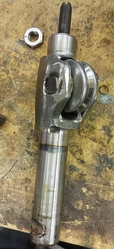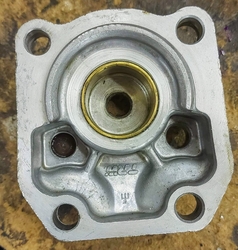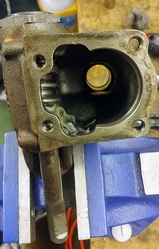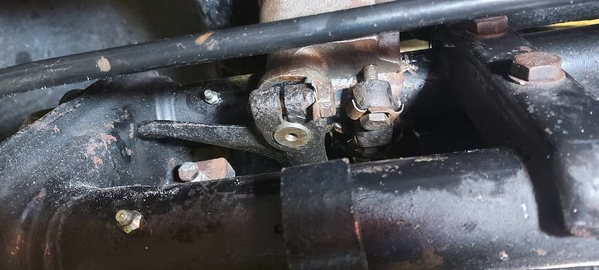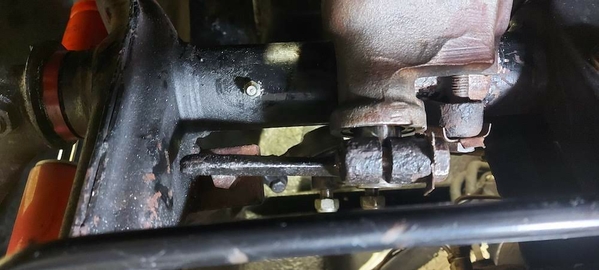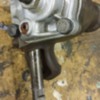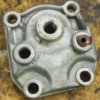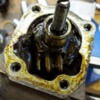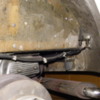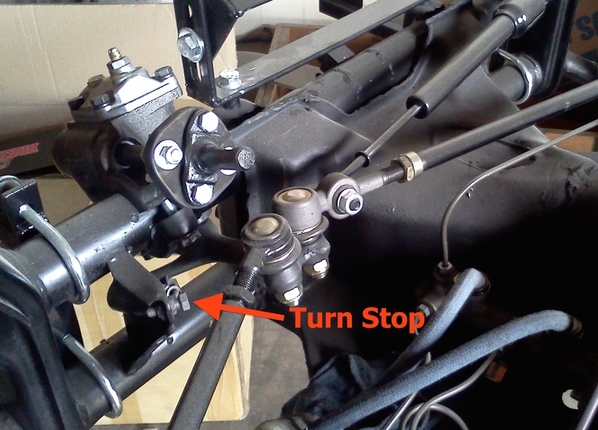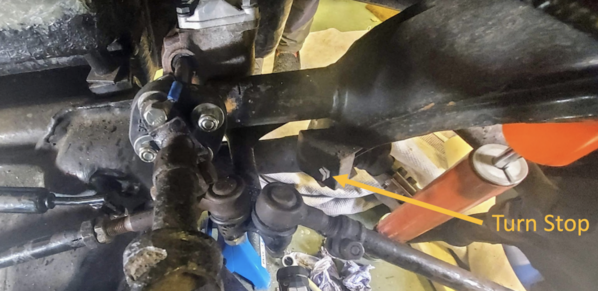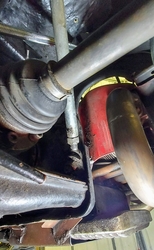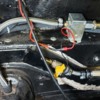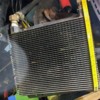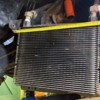As Lane said , for safety, best to replace the crush cage . Shift coupler: The red urethane will fail and best to use a German rubber type. Steering wheel to dash alignment : There are two 1/4" locator pins fused to the axle beam and depending the orientation you have the box clamp will put the steering shaft at a slightly different upward angle. To fix your steering wheel to dash alignment you can first remove the tie rods from the pitman arm then remove the steering box and remove two 1/4 pins off from the axle beam with a chisel, this will let you move the steering box a bit to slide to align the steering wheel to the dash and the difference on horizontal placement can be made up by readjusting the tie rods . After you replace the steering box and tie rods and are satisfied with everything you'll need to tack weld the clamp on the outer edge so if needed it can be removed at a later time. You will also need a front end alignment.
"Good afternoon (UK) and morning (USA) all. Hope you're enjoying your weekend."
You're missing a few countries there. You might be surprised at how many countries are represented on this site. ![]()
Keep your posts coming - they are interesting and informative.
![]()
Seconding Alan Merklin's advice: you MUST align the steering box to the steering shaft. It doesn't have to be perfect, but 5 degrees out is too much.
Ah well, I thought it was a bit too far out of true. From my ‘following the kit car scene at a distance’ over the last 30 odd years in the UK (it was the GP Spyder RSK that first ignited my passion for replicas), this kind of Heath Robinson, laissez faire attitude to doing things the right way seemed, to me at least, to hold back the industry for years. Not that it was necessarily deliberate, but that at the time no-one showed them the right way. A bit like the danger and lack of track/ car safety in Grand Prix in the 60s and70s was simply “part of the risk of competing”. And this was a ‘98 ‘factory built’ Chesil! I’m sure they thought as long as the body looked pretty everything else could be ‘good enough’. Or in this case, “the steering rag is rubber so it can flex a bit, that’s what it’s designed to do”..
I guess I’ll add relocating the steering box to the long to-do list. Seeing as I’m changing the tire diameter (increasing the tire height), I’ll need to adjust the ride height, and this will be a good time to sort the (leaking) steering box and reposition it on the beam before I get the tracking sorted!
Thanks one and all for your help as always.
I wouldn't put that on the "kit car scene." Fiberglass specials were invented in the UK. Lotus, Turner, TVR and numerous others (along with a few FRP aficionados in the states) pretty much invented a technology from scratch.
I'd put that down to shoddy workmanship on Chesil's part.
@dlearl476 you’re right, I apologise to the likes of Lotus, TVR etc. I was tired when I wrote that last night and was more referring to the high number of ultra small, single garage operations that popped up in the UK in the 70s and 80s trying to follow in their footsteps to produce a fibreglass- bodied car based on some kind of Spridget, Beetle or Metro chassis, usually with unbelievably ugly body designs and ill-thought out engineering. Lots of one-hit wonders without a hit.
I’ll stop now and extract foot from mouth!
I remember traveling to the UK in the 1980's and seeing all sorts of kit cars zipping about. As Martin mentioned above, some of them were really cool looking and had some good design under the covers, too, like a few home-built Lancia Stratos. Then, OTOH, there were a LOT that were pure abominations that not only would I never sit in one, It was just plain hard to look at them (like a Leige) where the best complement you could give was "What the hell were they thinking?"
Oh, and many thanks @Alan Merklin for the advice on moving the steering box.
Big thumbs up!
Oh dear, here we go again..
Removing the steering box to strip/clean/adjust, I thought I'd check how stiff the remainder of the steering setup is. With the right wheel being off the car, I went to the left side (against the garage wall - it's a fairly small garage) to pull the wheel left and right to check for any resistance. All the balljoints etc seem to be ok - not too stiff, all things considered. That's the good news..
Within the left (nearside for the UK) wheel arch - this is what a Chesil looks like inside the wheelarch, although I'm running a remote oil cooler which is non-standard.
Looking towards the front:
I spot this at the back of the wheel arch..
On closer inspection:
For some reason I can't fathom, one is worn down to the braid at a point where it doesn't rub against anything. Ah well, looks like new hoses are in order - to run from the oil filter at the back of the left rear wing all the way to the front.
Sometime, ignorance is bliss. But then Sod's Law would mean this hose would give way whilst driving. But unlike the last one it wouldn't signal to me with a huge plume of smoke, it would just dump the oil and either ruin the engine or the back tyre would slide out on a corner.
At least my wrist is out of plaster now so I've got one and a half hands to start mechanicing again :-)
Attachments
One of our other members lost an oil line that was in a similar location. His tire was rubbing the line because of low air pressure causing the tire to bulge more. During spirited driving the sidewall flexed more which caused it to rub. Eventually the hose developed a leak. Luckily his fuel pump was wired in such a way that when he lost oil pressure the fuel pump shut off.
Hi @Robert M I can see why that would happen. I've got 195/55/15s and for sure they are wide for 'standard' wheel arches, hence me wanting to swap them for narrower tyres. You'll see from elsewhere on this thread I have a problem with the brake hoses rubbing on the tyres at full lock. However, in this case, the wheel is nowhere near the hose - it's a very odd puzzle I can't figure out, unless something like a flint was thrown up and sliced the rubber. More likely the P-clips fixing the hose to the body broke and the hose fell loose and rubbed on either the body or the tyre - this has obviously been fixed at some point.
@Martin's Eleven (UK)- You say those are oil lines running to a front mounted cooler? Have you considered relocating the cooler to the back left fenderwell?
I didn’t realize those cooler lines were in the front wheel well. The member I was referencing had his oil filter and lines in the left wheel well.
I suspect you’re right that the line came loose from its mount and rubbed a bit before being fixed.
Those look too small to be oil lines.
@edsnova hmm, they're 0.8"/ 20mm OD (I've not checked ID, but googling similar shows an ID of 0.5"/13mm). But they're definitely feeding oil to the cooler.. Which then begs the question, what kind of efficacy will there be if the oil has to go 8 feet forward to the cooler, then 8 feet back to the engine. One could argue that it would give the oil longer to cool down, but the flipside is that the oil may struggle to come back from the cooler if it's thicker? I'm guessing it would depend on what temp the thermostat opens up?
One other question I was going to ask, given this is a 22+ year old conversion so I've no real history of why certain build decisions were made.. As this is a 1904cc build with some kind of hot cam (not sure what yet), does it benefit from both an additional slimline sump for greater capacity AND a full flow oil filter & cooler? I'm betting the answer is "given oil does double duty in terms of lubrication and cooling, then any help in looking after that oil is a good thing". But I'm happy to be corrected if wrong.
So, parking the oil hose for a while, it's back to the steering box alignment..
Of course, some of the problems I'm coming across will not occur with Left Hand Drive models, and vice versa..
First things first, remove steering box, strip it down and inspect. The idea being not to make it perfect, but if it was serviceable then I'd use it and, if not, I'd replace it. It was incredibly greasy/oily on the outside, with leaks coming from most areas. It was also very stiff to turn around the centre mark but easy at either end.
So, a few pics before and after..
As you can see, a bit gooey. In amongst all that (at least 20 years old) decayed grease was one of the two plastic plugs - the old one had obviously perished when a PO was trying to pull it out of the top, so they had just pushed the rest in and stuck a new plug in the hole..
A good clean up and everything seemed to be pretty tight, with no real play in any area.
I reassembled all parts without grease and adjusted it to see how much play (or lack of) was in the system. Actually, it was all pretty good. So I reassembled with lithium grease, tightened everything down and adjusted again. We'll see in time whether the old seals will hold or whether I will need to get new ones.
Now for the real problem. As some of you saw in an earlier post, the box is out of alignment with the steering column. To fix this, as @Alan Merklin said, I would need to chisel off the two locating lugs on the front beam then slide the box further to the right side of the car (to the left in the pics). Problem - if I go any further to the outside of the car then the steering stop arm hits the beam upright. The pictures below show the standard location of the steering box - which gives about 5mm clearance. It looks like I will have to grind that down so I can move the box further to the outside of the car. I don't really want to remove it completely, otherwise there's no limit to 'full lock' which usually means something rubs something else and trouble ensues (ooh, matron!).
Attachments
@Martin's Eleven (UK) posted:@edsnova hmm, they're 0.8"/ 20mm OD (I've not checked ID, but googling similar shows an ID of 0.5"/13mm). But they're definitely feeding oil to the cooler.. Which then begs the question, what kind of efficacy will there be if the oil has to go 8 feet forward to the cooler, then 8 feet back to the engine. One could argue that it would give the oil longer to cool down, but the flipside is that the oil may struggle to come back from the cooler if it's thicker? I'm guessing it would depend on what temp the thermostat opens up?
One other question I was going to ask, given this is a 22+ year old conversion so I've no real history of why certain build decisions were made.. As this is a 1904cc build with some kind of hot cam (not sure what yet), does it benefit from both an additional slimline sump for greater capacity AND a full flow oil filter & cooler? I'm betting the answer is "given oil does double duty in terms of lubrication and cooling, then any help in looking after that oil is a good thing". But I'm happy to be corrected if wrong.
There's zero benefit, IMHO, in having the oil cooler all the way at the front of the car. Mine is positioned along the fram of the car forward of the axles and I've never had an overheating issue. The cooler has a thermal switch activated fan pack.
And yes, you would benefit from having a the motor set up for a full flow oil filter. And I think the majority of us run with an additional slimline sump. Except for the truly mad who run with a dry sump system.
Half-inch ID is probably fine even for the front but as Robert says, "while you're at it," a move to a spot in the rear wheel well might be of benefit.
.
If memory serves, a reason for not having the cooler up front is that a larger than normal oil pump is usually recommended to keep things flowing.
At first glance, it looks like there's not enough room in the rear wheel well for a cooler and fan, but there is, if the right cooler is chosen and it's installed by someone who's done it before.
Your oil lines look to be mounted where Porsche mounted theirs for cars with the exotic four-cam engine (that used a front-mounted cooler). Their cooler had no electric fan, so probably benefited from being up front. But their lines in that location were metal and mounted with clamps that were meant to last a thousand years.
The extended sump was first devised to keep a deeper well of oil around the pump pickup so as not to run dry in hard cornering. The added volume helps a little, but not too much.
What usually happens in discussions like this is that someone who doesn't know much (like me) will toss out some bits he remembers reading and get half of them wrong, which annoys someone more expert than me, who, in turn, will post a follow up to correct the errors.
Wait around here long enough, and the truth will out.
.
OK, so I covered the installation of a complete full flow cooler/filter package a long time ago and the parts that pertain to "where to put the filter" are here:
https://www.speedsterowners.co...-1-mechanical-layout
and here:
https://www.speedsterowners.co...-cooler-installation
There's two more sections up under the Resource/Knowledge section - Check 'em out.
The Photobucket photos are now useless (Damn you, Photobucket!) so I'll add a few pertinent cooler location photos as attachments to this. If you need explanations of the photos, just ask, but it's all in the articles.
Now, on the "We'll see in time whether the old seals will hold or whether I will need to get new ones." Trust me. The old seals leaked and re-using them just guarantees that they'll leak again. There are two circular seals and one big, complicated paper gasket and they all need to be replaced or it's gonna leak again. Get on it now, while it's still easy to do.
Havin' fun yet?
Attachments
Oh, and a BIG reason to re-consider having the oil cooler way up front is (1.) you'll need a 30mm HD oil pump to move an adequate volume and (2.) the oil actually moves slower the closer you get to the inside walls of the hose it's traveling in because of "Wall Friction" (I made up that term, but you get the idea). The longer the hose (and the more turns) the slower the oil will flow AND the more power it'll take to force it through the hose(s). Just think "short is sexy" as a mantra for cooler and hose locations.
To add one more voice to a chorus:
Don't put the cooler back in the front unless you have a dry-sump. I HAVE a dry-sump and my cooler is in the LR wheelwell, because it works fine there and nobody needs 20 ft. of extra line to pump through (even if one has a scavenge stage on the oil pump).
If you're set on leaving it there, at least get an Accusump and a 30 mm oil pump, along with a size jumbo extended sump.
@Gordon Nichols posted:Oh, and a BIG reason to re-consider having the oil cooler way up front is (1.) you'll need a 30mm HD oil pump to move an adequate volume and (2.) the oil actually moves slower the closer you get to the inside walls of the hose it's traveling in because of "Wall Friction" (I made up that term, but you get the idea). The longer the hose (and the more turns) the slower the oil will flow AND the more power it'll take to force it through the hose(s). Just think "short is sexy" as a mantra for cooler and hose locations.
Gordon, I think the correct term is surface friction.
Here's some food for thought wrt running a front mounted cooler:
And the thread I found it.
Attachments
Regarding your steering box (and the adjustment of)- please note that these things don't use "grease", as grease will not flow back into the areas between the gears when it's been "squished out. They use an extremely thick oil which continually flows back into place, which I believe you can make by a bit of grease and oil together. Ages ago I posted a link to a thread on another site which detailed taking one apart and setting it up properly (and what to use as lubricant)- I'll see if I can find it. Al
PS- And to add just 1 more voice- there really is no need to run oil lines all the way to the front of the car (and back). A cooler with temp controlled fan and full flow filter assembly (which, if you pick the right 1 will have a thermostat built in so oil isn't sent to the cooler until the oil need the extra cooling capacity) mounted in the left rear wheel well has already been proven to work and there's not the wasted power of the larger pump pushing oil along 20 extra feet of line.
Even rubber lined stainless steel hose has pumping loss- the best choice is to use teflon lined hose.
Another PS- (the important 1)- I found it- check out Hotrodsurplus's post about half way down the page- rebuilding steering boxes
If you're going to run the lines up front and back, you need to use AN-10 or AN-12, which are 5/8" and 3/4" I.D. respectively.
AN-8 (1/2" I.D.) is totally adequate if all the oil lines are kept within the vicinity of the engine bay.
I've had a 26mm pump with Berg pressure relief cover, full flow, thermostat, filter, cooler and 1.5 qt. slim sump. It worked GREAT and cooled effectively. I used AN-8.
I now have a dry sump and use AN-8 on all pressure lines. I use AN-10 on all the scavenge lines.
@ALB posted:Another PS- (the important 1)- I found it- check out Hotrodsurplus's post about half way down the page- rebuilding steering boxes
This is a great link. When I rebuilt the steering box on my old '64 bus a hundred years ago my friend's father said, just use STP in it. So we did.
Then I read through this tonight and , what do you know? His old man was right on!
"...It looks like I will have to grind that down so I can move the box further to the outside of the car. I don't really want to remove it completely, otherwise there's no limit to 'full lock' which usually means something rubs something else and trouble ensues (ooh, matron!)." - @Martin's Eleven (UK)
I don't know if this would apply to your chassis/steering box or if it would be of any help but here is a picture of the 'turn stop' on most all of Vintage Speedsters (Kirk Duncan) here in U.S.
Attachments
Here's a link to a previous post I made on where my oil cooler was mounted:
Guys, many thanks for all your comments and time taken to pass on your knowledge. Much appreciated as always. And I hope you like the picture-book blow-by blow account I'm posting here as I work through my to-do list (and uncover more problems as I go!).
@ALB and @Gordon Nichols - point taken on the steering box. I'll strip it down, get new seals and fill with oil not grease. I thought I was doing the wrong thing using grease but I couldn't find the relevant post on here. Just shows - a little more patience using this site saves me untold pain in the garage!
And yes, Gordon, I am havin' fun, despite making a few rookie mistakes. :-)
As for the oil cooler, it absolutely makes sense to move it back into the rear wheel arch and lose 16 feet of hose. Gordon, you mention wall friction - I knew there was a reason for not having the cooler up front and you nailed it. More commonly known as pipe friction, there is a known formula for calculating the loss of pressure along a given length and ID of pipe by a fluid of known viscosity. I know of this phenomenon more because I follow pro cycling/Tour de France etc - in a sprint finish the riders always ride by the barriers because there's less headwind than in the middle of the road. But for hoses, "short is sexy" works for me.
I'll go out and have a look in the garage later (once I've finished some 'real' work for the day to help pay for all this!). I can feel the huge Sidewinder-style exhaust will cramp the ability to locate everything without it getting too hot or close to the wheel. And tryng to bend steel-braided oil hoses in any kind of tight radius is near impossible, as no doubt all of you know.
Yeah, SS braided hoses require angle fittings on most direction changes on these cars for lack of much space. Fortunately, lots of different angle fittings are available.
Amazing Tour this year, right? I couldn’t believe how tough it was every single day. Way too tough for a Geriatric rider like me. And it looked like Sagan’s last season.
@MusbJim thanks for the steering stop pics. Here's one of my RHD version showing the (stock) welded stops.
I'll have to look in to this more carefully to see how I can move the steering box further to the right (looking towards the front of the car) in order to align the steering box/steering column and 'straighten' the steering column. I'll have to bribe my brother with beer as he's the one who can weld. He was a smart cookie and more mechanical than I - he did an evening class in welding when he was 17.
I wonder if I could reverse the steering arm/ pitman arm? Is this possible?
p.s. re: oil cooler pipes - @dlearl476 those are some scary figures in your chart for psi loss per foot length! Thanks for that - most useful.
Attachments
Could you fit in a U-joint?
@Martin's Eleven (UK) posted:I wonder if I could reverse the steering arm/ pitman arm? Is this possible?
I'm not sure from looking at your's, but I believe there was a specific pitman arm for RHD VW bugs. If your pan was converted to RHD in someone's drive, maybe you don't have a RHD pitman arm? Just a thought. No mater where in the world we are, a second hand, home built, speedster will have interesting secrets to reveal.
A quick post-Christmas update. As ever, the to-do list doesn't shorten.. For every job knocked off the list I find another point to address on the car.
I've replaced the 20 year old fuel hose throughout the car and here's the rough fit for the front end connecting the fuel tank to the shut-off valve, filter and fuel pump:
It needs some tidying and I'm awaiting rubber mounts for the Facet pump (more on this pump in a minute). The fuel filter will be replaced by a metal one when the next postal delivery arrives. In the meantime, I think having the filter horizontal should help filter out crud more effectively than if it were tilted (more surface area on which the crud can rest).
Talking about the Facet pump, I'm considering getting a Carter pump or similar (because Carter's are difficult to find and expensive in UK). Here's the noise from the current Facet pump:
I'l see that the noise is like once I isolate it on rubber mounts. I'm presuming I can't 'wrap' it in any kind of sound insulation because it might overheat?
One piece of good news - after 3 months of looking on Ebay and Gumtree, I finally found a Dellorto Super Performance manual for the DRLAs and, because they're as rare as hen's teeth over here, I was prepared to go high (£50!) in my bidding but in the end I was the only bidder and won it for £13 (around $18). Again, I'm awaiting this in the post since the seller has had to self-isolate due to Covid (we're having a massive increase in numbers - the hospitals are filling up fast) and can't get to the post office. I'm not a carb specialist so I wanted the manual before even beginning to look at the DRLAs. However, that gives me time to get the whole fuel chain from tank to carbs cleaned/renewed.
Other than that, I'm going to get my local air-cooled VW specialist to move the front-mounted oil cooler to the rear wheel arch and fit a fan to it - let him deal with all the contorting himself to work within a confined space and sort those AN hose fittings etc. It's a very sturdy, well protected 11"x9" cooler which is good news!
Oh yes, the new tasks.. Looking under the rear the other day to feed the new fuel hose up from the chassis tunnel to the rear bulkhead, I noticed the tell-tale spray of CV joint grease and perished CV boots.. Ah well, that Trello board keeps getting busier! :-)
Attachments
On that Facet pump: That's what I originally had in my car when I first built it. It simply drove me nuts. It has that aggravating clatter going on all the time and even mounting it in rubber didn't really help all that much.
If you have your heart set on a Facet (they do move the fuel to the carbs well, after all) Aircooled.net has fuel pump rubber isolators that, they say, effectively isolate the pump from ringing the frame. Look Here> http://vwparts.aircooled.net/category-s/173.htm Scroll about halfway down. You can probably find something locally at a DIY store.
Or you can save yourself the aggravation and get a rotary pump from CB Performance, Carter or Aircooled - There must be rotaries for sale in the UK, as a lot of larger displacement VW sedans are zipping around over there.
The Facet has the correct sound for a Carrera; sounds like that original pair of AutoPulse 500s that were ganged together to feed the 4-cam engines. It'll impress the heck out of that one Porschephile concourse judge. You'll know him when you encounter him: bowler hat, bow tie, creased tweeds—and when he hears that clackity-clack he'll wink at you knowingly.
It's not a sexual thing. It's just how serious Porsche guys are.
@edsnova posted:The Facet has the correct sound for a Carrera; sounds like that original pair of AutoPulse 500s that were ganged together to feed the 4-cam engines. It'll impress the heck out of that one Porschephile concourse judge. You'll know him when you encounter him: bowler hat, bow tie, creased tweeds—and when he hears that clackity-clack he'll wink at you knowingly.
It's not a sexual thing. It's just how serious Porsche guys are.
Oh no, Ed, with those tweedy concours guys it often IS a sexual thing. Freud would have a field day.
Thanks guys, I'm afraid I'm not of the Tweed Porschephile concours type! If I ever need to impress someone with a Facet pump noise, I'll slap myself around the chops with a wet haddock and 'snap out of it'.
I've assembled everything for now using the Facet pump and rubber isolating mounts which achieve exactly zero decibel reduction, but at least they don't amplify the noise through the chassis.. I'll buy and fit a rotary pump and that should make things far quieter and allow _just_ the engine note to be heard.
I've reassembled the whole front - I just need to bleed the brakes. I lent my brake bleeding kit (that runs off the air compressor) to my brother so I'll make do with introducing the wife to the delights of 'up, down, up, down..' I'll pull in my marker after she requested I make home-baked chocolate fondants last night. :-)
I've also replaced the gearshift coupling so am now heading to the rear of the car to tackle the carbs, engine, clean up that Porsche fan shroud and fix the air gaps between top and bottom engine halves. I want to get it mobile again so I can jetwash the huge amount of oil from underneath so I can more clearly see further problems (before fixing the CV joint etc).
One question I forgot to ask from a long time ago regarding the sebring style exhaust - why would the PO or original engine builder fit a 40mm ID exhaust when the exhaust manifold is only 34mm ID? I'll dismantle soon and take some pics to see if there is a rational explanation, or if that is 'just the way it is'.
Martin wrote: "Why would the PO or original engine builder fit a 40mm ID exhaust when the exhaust manifold is only 34mm ID?"
Good question. If it were a 2-stroke motorcycle or snowmobile, I would think it was a poor man's attempt at an expansion chamber but in your case it might simply be that that's what was available and........ It fit.
The 40mm will allow a bit better flow, but if you have 34mm carb venturiis and 34mm head ports then the additional flow will amount to mice nuts. I don't think it will hurt it or decrease HP - I think it will increase your torque band very slightly in RPM but I'm not certain of that.
It won't add anything, either, IMHO, unless you increase the flow elsewhere (bigger carb venturiis plus bigger head ports and maybe increase the runner diameters on your intake manifolds - All this starts to be a lot of work and £££).
But, let's get a few comments from our North American motor-head neighbors, like @ALB and @Stan Galat and @DannyP. I no longer have access to my flow analysis programs in "Pro Engineer" (I retired and couldn't afford the Sun server they were running on) ![]() but these guys are more familiar than me with what works.
but these guys are more familiar than me with what works.
I'm feeling lazy this morning, and didn't read through the thread. What do you have for an engine (displacement, cam, carbs, and heads)?


